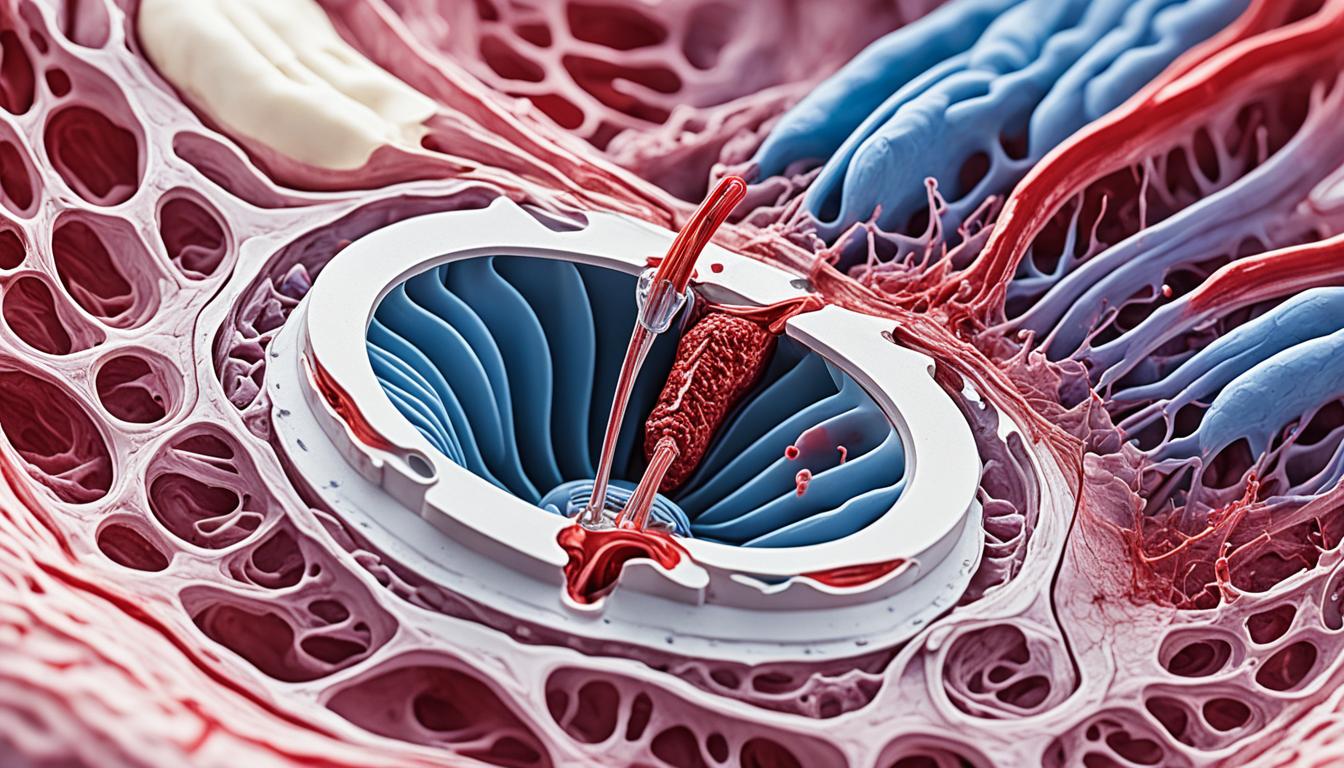Tricuspid valve regurgitation impacts how the tricuspid valve works. This valve sits between the right ventricle and right atrium of the heart. It leads to blood flowing back into the right atrium during systole. Instead of heading to the lungs, where it should go, this blood goes the wrong way. The severity of tricuspid regurgitation varies, from mild to very severe.
Many things can cause tricuspid regurgitation. Some reasons include right ventricular stenosis and infective endocarditis. Even factors such as using weight loss pills, thoracic trauma, and certain health conditions like lupus and rheumatoid arthritis can play a part.
Key Takeaways:
- Tricuspid valve regurgitation is a condition where the tricuspid valve fails to close properly during systole.
- This condition can lead to blood flowing back into the right atrium instead of being pumped out to the lungs.
- Tricuspid regurgitation can range in severity from mild to very severe.
- Causes of tricuspid regurgitation include right ventricular stenosis, infective endocarditis, weight loss pills, thoracic trauma, and certain medical conditions.
- It is important to work closely with healthcare providers to determine the most appropriate treatment plan based on the severity of the condition and individual health.
Symptoms and Diagnosis of Tricuspid Regurgitation
Tricuspid regurgitation is a condition that affects the tricuspid valve. This valve sits between the heart’s right ventricle and right atrium. Mild cases might not show any signs. But, moderate to severe cases can cause issues.
As the seriousness of tricuspid regurgitation grows, so do the symptoms. Early on, people with mild cases might not feel anything. But, as it worsens, signs can include:
- Shortness of breath
- Fatigue
- Heart rhythm disturbances
- Chest pain
- Dry cough
- Lower extremity edema
In worse cases, heart failure is possible. This leads to signs like swelling in the belly and legs, fast weight gain, and trouble breathing, even when not active.
To diagnose tricuspid regurgitation, doctors perform various tests. Echocardiography is one important method. It checks the seriousness of the issue and the valve’s function. Doppler echocardiography, a specific type, shows blood flow volume and direction. This helps in assessing the condition.
Other tests such as ECG and cardiac MRI might also be done. They look deeper into heart health, checking its rhythm and structure.
Example Table:
| Diagnostic Test | Purpose |
|---|---|
| Echocardiography | Evaluating the severity of tricuspid regurgitation and assessing the function of the tricuspid valve |
| Doppler echocardiography | Providing detailed information about the direction and volume of blood flow |
| Electrocardiography (ECG) | Evaluating heart rhythm and identifying any abnormalities |
| Cardiac MRI | Assessing the structure and function of the heart chambers and identifying any underlying conditions |
These tests are vital for an accurate tricuspid regurgitation diagnosis. They also help in planning the right treatment. Finding and diagnosing it early is key. It allows for timely care, keeping heart health in check.
Treatment Options for Tricuspid Regurgitation
The treatment of tricuspid regurgitation deals with how bad it is and if there are symptoms. When it’s mild, lifestyle changes may be enough. This includes stopping smoking, drinking less alcohol and caffeine, and eating well and staying active.
For those with a moderate to severe problem, medicine can help manage symptoms and improve heart function. Doctors may prescribe diuretics, beta-blockers, or ACE inhibitors to reduce fluid, control heart rate, and decrease blood pressure.
If the case is serious, surgery might be the best option. Repairing the tricuspid valve is one option. This fix can either be to fix the leaflets or strengthen the annulus. If the valve needs to be replaced, a new valve could be mechanical or made from animal tissue.
A new, less invasive method uses transcatheter devices for repair. Doctors can often do this without a big opening in the chest. They guide the device to the valve through a blood vessel with a catheter. This is a newer but promising way to treat tricuspid regurgitation.
Stem cell therapy is also becoming a focus for treatment. It aims to repair heart tissue using stem cells from either the patient or a donor. This method is still being researched but shows potential for improving heart health. As of now, it is not a widely used treatment.
Takeaway:
Tricuspid regurgitation has many treatment paths, from simple lifestyle changes to complex surgeries. Each case is different, and the best option is decided by the patient and their doctor. While new options like stem cell therapy exist, they are not the standard and require more study.
Conclusion
Tricuspid valve regurgitation is a common issue with heart valves. It can be mild or severe. Mild cases often show no symptoms and are seen as normal. But in severe cases, it can cause heart failure and other problems.
Doctors usually diagnose this issue using echocardiography. This test gives a detailed look at the tricuspid valve’s function and the amount of regurgitation.
Managing mild tricuspid regurgitation includes lifestyle changes. Quitting smoking, eating well, and regular exercise are key. For more severe cases, medicines can be used to help with symptoms and boost heart function.
If things get really serious, surgery might be needed to repair or replace the valve. There’s also a less invasive method using special devices – known as transcatheter repair techniques. Plus, there’s the exciting possibility of stem cell therapy. This new therapy can help renew the heart’s damaged parts.
Those dealing with tricuspid regurgitation should talk a lot with their doctors. Together, they can figure out the best plan for treatment. There are many options available, so being informed is important. This way, patients can help manage their condition well.

